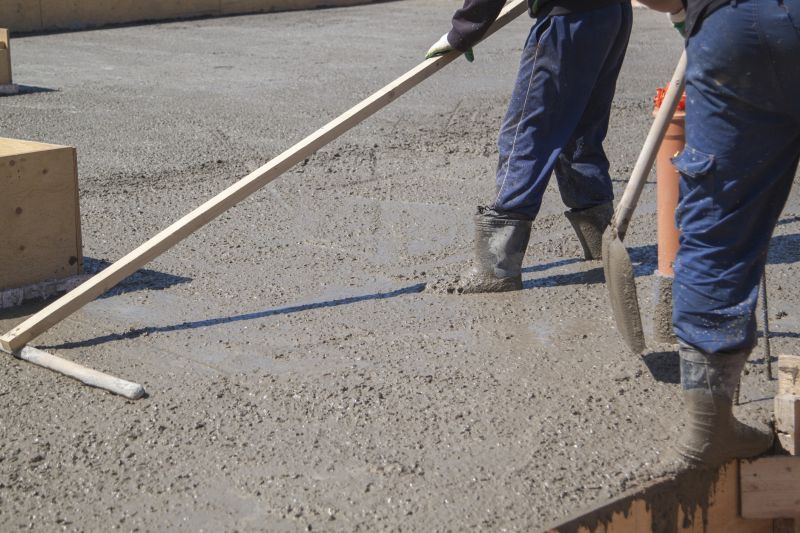Ultimate Product Guide For Concrete Leveling Equipment
Find out which tools and materials are favored by experts for achieving perfect concrete surfaces quickly and safely.
 Concrete leveling is an essential process for maintaining the safety, appearance, and functionality of various concrete surfaces around properties. Over time, concrete slabs can settle, crack, or become uneven due to soil movement, moisture changes, or structural shifts. Properly addressing these issues helps prevent further damage and ensures surfaces remain level and safe for foot or vehicle traffic. There are numerous products available designed to facilitate effective concrete leveling, ranging from DIY kits to professional-grade solutions.
Concrete leveling is an essential process for maintaining the safety, appearance, and functionality of various concrete surfaces around properties. Over time, concrete slabs can settle, crack, or become uneven due to soil movement, moisture changes, or structural shifts. Properly addressing these issues helps prevent further damage and ensures surfaces remain level and safe for foot or vehicle traffic. There are numerous products available designed to facilitate effective concrete leveling, ranging from DIY kits to professional-grade solutions.
Top Overall Option
Polyurethane Concrete Leveling Kit
A versatile polyurethane-based leveling kit offers a semi-permanent solution for filling voids and leveling uneven concrete surfaces. It is suitable for various project sizes and provides quick curing times, making it a popular choice for both DIY enthusiasts and professionals. The kit typically includes the necessary tools for mixing and application, supporting precise repairs and minimal surface disturbance.
Types of Products For Concrete Levelings
Polyurethane Foam Injection
Used for lifting and leveling sunken slabs by injecting expanding foam beneath the surface.
Concrete Patching Compound
A ready-mix or premixed material designed to fill cracks, holes, and minor surface irregularities.
Self-Leveling Underlayment
Fluid compounds that create a smooth, level surface over uneven concrete slabs.
Epoxy Concrete Repair
High-strength epoxy resins used to bond and fill larger cracks and damaged areas.
Cement-Based Patch Mix
Traditional repair material suitable for filling larger voids and restoring surface integrity.
Hydraulic Cement
Quick-setting cement ideal for sealing leaks and repairing cracks that require rapid curing.
Polymer-Modified Concrete
Enhanced concrete mixes that improve adhesion and flexibility for repairs.
Concrete Leveling Pumps
Equipment used to efficiently deliver leveling compounds into difficult-to-reach areas.
Slab Jacking Foam
Specialized foam used to lift and stabilize sunken slabs without extensive excavation.
Crack Repair Kits
Comprehensive kits containing fillers, sealants, and tools for crack sealing.
Fiber Reinforced Patching
Materials embedded with fibers to enhance crack resistance and durability.
Liquid Cementitious Pours
Pourable formulas that create a smooth, even surface over uneven slabs.
Popular Choices
Widely used for lifting and leveling sunken concrete slabs with minimal disruption.
Commonly used for sealing small cracks and preventing further damage.
Popular for creating smooth, even surfaces on interior slabs and floors.
Valued for their strong bonding properties and durability in repairing structural cracks.
Favored for rapid setting and sealing of cracks and small holes.
Chosen for its enhanced adhesion and flexibility in various repair scenarios.
Essential for efficient application of leveling compounds in larger projects.
Popular for lifting and stabilizing uneven slabs with minimal excavation.
Used for sealing and preventing water intrusion in cracks.
Provides added strength and crack resistance for repaired surfaces.
Commonly used for interior floors and large flat surfaces needing smoothness.
Help accommodate movement and prevent new cracks.
When selecting products for concrete leveling, it is important to consider the specific type of issue, the size of the area, and the underlying causes of unevenness. Many products are tailored for small repairs such as cracks or minor settling, while others are suitable for larger, more complex projects. Using the right product can improve the efficiency of the repair process and help achieve a more durable, long-lasting result.
In addition to choosing the appropriate product, understanding the application process and safety precautions is vital. Some leveling compounds and fillers require mixing and precise application techniques, while others are ready-to-use for quick repairs. Proper surface preparation, including cleaning and removing loose debris, enhances adhesion and the overall success of the leveling effort. Whether tackling a driveway, patio, sidewalk, or interior slab, selecting the right tools and materials is key to a successful project.
Overall, investing in quality products for concrete leveling can help homeowners and contractors maintain the integrity of their surfaces. While the scope of work varies, the goal remains consistent: restoring a level, stable, and safe surface that meets the specific needs of the space. With a broad range of options available, there are solutions suitable for both minor touch-ups and extensive repairs, making concrete leveling more accessible and manageable for various projects.
Key Buying Considerations
- Identify the specific issue with the concrete, such as cracking, sinking, or unevenness.
- Determine the size of the area needing repair to select appropriately scaled products.
- Consider the type of surface—indoor or outdoor—and choose suitable materials accordingly.
- Assess whether a quick-setting product or a longer curing time is preferable for your project timeline.
- Check compatibility of repair materials with existing concrete or other materials involved.
- Evaluate the ease of application, especially if opting for DIY repairs, and review product instructions carefully.
- Prioritize products with good adhesion properties to ensure long-lasting repairs.
- Consider the environmental conditions—such as moisture levels—that may affect the curing process.
- Review safety precautions and required protective gear when handling chemical-based products.
- Estimate the amount of product needed to avoid shortages or excess waste.
- Look for products that allow for future repairs or adjustments if needed.
- Determine if the product offers flexibility to accommodate slight movements or expansion.
- Research the durability and resistance to weathering or wear for outdoor applications.
- Consult with a professional if dealing with extensive structural issues or large-scale repairs.
- Compare costs relative to the scope of the project to find a balance between quality and budget.
